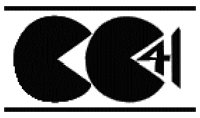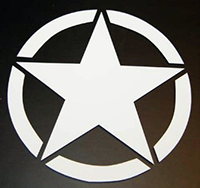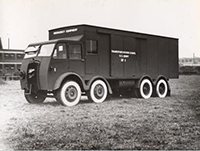


The Utility Clothing Scheme (and later utility furniture), was a rationing scheme introduced in the United Kingdom by the British Government during World War II. In response to the shortage of clothing materials and labour due to the requirements of the war effort, the Board of Trade sponsored the creation of ranges of "utility clothing" and furniture meeting tight specifications regarding the amount of material and labour allowed to be used in their construction - these articles could be identified by presence of the CC41 mark.
To purchase utility clothing it was necessary to use clothing coupons. Anyone getting married or setting up home had to save, beg and borrow points to buy clothes and bedding. This continued post the end of WWII until it was finally withdrawn in 1952.
The famous white star found on some WW2 vehicles is often mistaken for being an American symbol. Hollywood has done much to associate the star with only American units, when in fact, it was a sign given to all allied troops especially in the build-up to D Day.

London's famous red buses have more of a War connection that you might think. During the war London Transport was heavily involved in war work, including adapting vehicles for D-Day.

View of a US Army Lorry built at the L.T. Acton Underground Works during the Second World War.
For example the L.T. works in Aldenham were turned over to the London Aircraft Production organisation and used to assemble Halifax aircraft.

Aircraft being assembled at Aldenham
The capital's famous Routemaster buses used a lot of engineering experience gained in the construction of Halifax Bombers (for example, the use of hydraulic braking). After the war, the Aldenham works became famous as the overhaul building where buses were refurbished. Sadly, the Aldenham works closed in 1986.
List of stores relating to portable cooking equipment, available to the British Army, dated 1939. 16 pages.
AEC Matador 4x4 tractor drivers handbook, for vehicles with air assisted hydraulic brakes, dated 1943. 68 pages.
A guide for novice drivers on the handling of AEC army vehicles, dated 1940. 24 pages.
Post WW2 M20 3.5 inch Bazooka, anti-tank launcher handbook, dated 1952 amendments 1955. 59 pages.
Pictorial layout of the Bren Light Machine Gun Holdall, this would also have held a spare barrel, not shown, circa 1942.
Sten Sub-Machine Gun Mk 1,2 & 3 illustrated parts list, enabling armourers, to order replacements parts as required, dated 1942. 23 pages.
A history of the use of the US M1 & M1A1 Flamethrower in WW2. dated 1949. 382 pages.